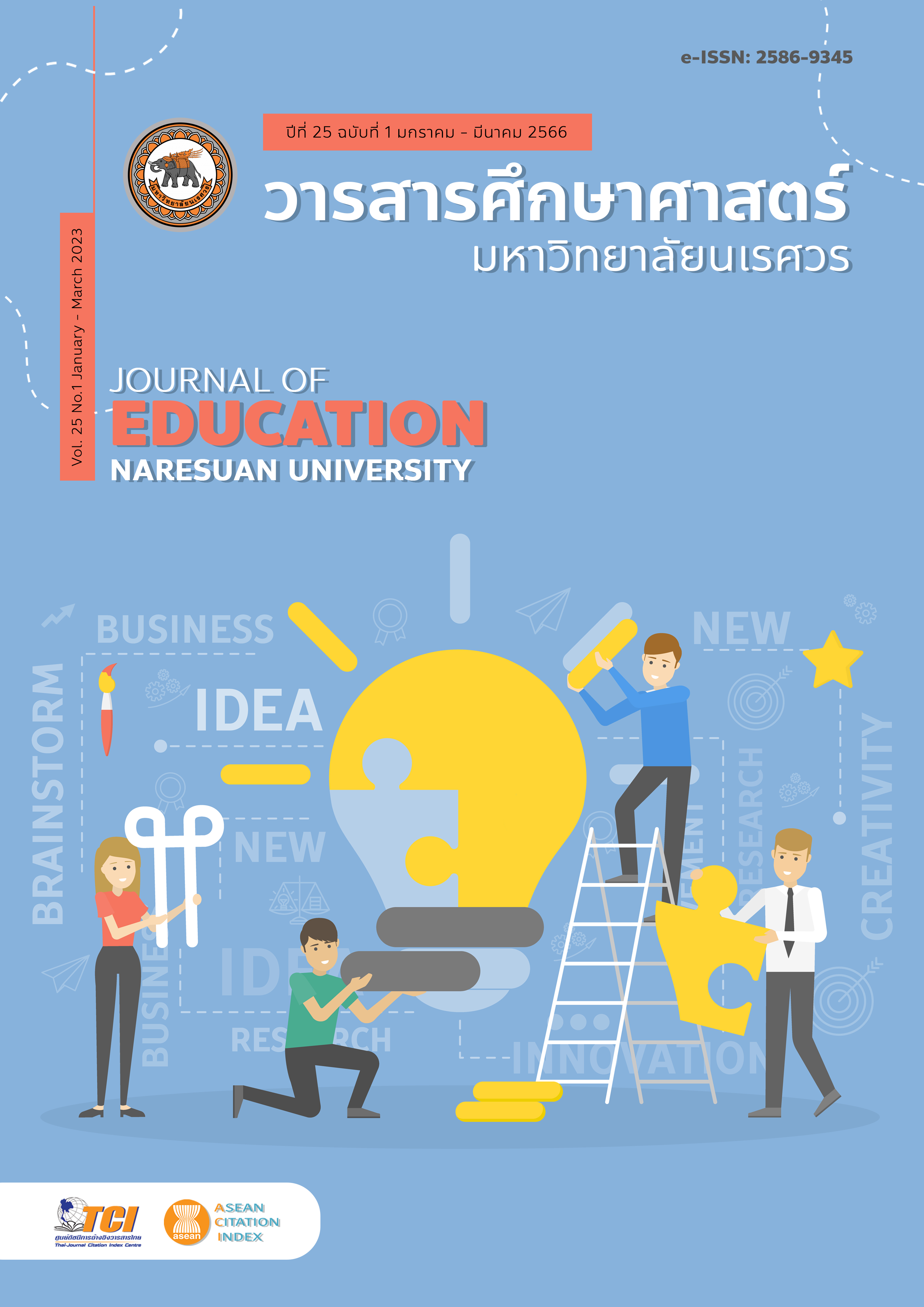DEVELOPMENT OF TEACHING ACTIVITIES BASED ON ONLINE EASA INSTRUCTIONAL MODEL TO ENHANCE SPEAKING ABILITY OF THAI EFL STUDENTS
Main Article Content
Abstract
This study aimed to 1) explore the effects of the online EASA instructional model on the speaking ability of Thai EFL students and 2) investigate the students’ perceptions towards learning through the online EASA instructional model. Thirty eleventh grade students in the first semester of the academic year 2021 at a public school in Nakhon Pathom province, Thailand, were selected as participants for this study by using the convenience sampling method. This study employed a single group pretest and posttest design. The research instruments included 1) English speaking pretest and posttest 2) close-ended questionnaire and 3) interview questions about participants’ perceptions towards learning through the online EASA instructional model. The data analysis employed the statistics of paired-sample t-test, mean, standard deviation, and content analysis. The results indicated that 1) students’ posttest mean score after learning through the online EASA instructional model was higher than the pretest mean score at a significant level of .001, and the results of the questionnaire and semi-structured interview revealed that 2) students had positive perceptions towards learning through the online EASA instructional model.
Article Details

This work is licensed under a Creative Commons Attribution-NonCommercial-NoDerivatives 4.0 International License.
The owner of the article does not copy or violate any of its copyright. If any copyright infringement occurs or prosecution, in any case, the Editorial Board is not involved in all the rights to the owner of the article to be performed.
References
Alkan, H., & Bumen, N. T. (2020). An action research on developing English speaking skills through asynchronous online learning. International Journal of Curriculum and Instruction, 12(2), 127-148.
Amirulloh, D. N. K. S., Damayanti, I. L., & Citraningrum, E. (2020). Flipgrid: A pathway to enhance students’ speaking performance. Proceedings of the Thirteenth Conference on Applied Linguistics of Advances in Social Science, Education and Humanities Research, 546. https://doi.org/10.2991/assehr.k.210427.014
Ariani, S., & Tawali, T. (2021). Problems of online learning during Covid-19 pandemic in speaking for professional context class. Journal of English Language Teaching, 8(1), 32-37. https://doi.org/10.33394/jo-elt.v8i1.3783
Cambridge Assessment English. (2015). B2 first for schools exam format. Cambridge English. Retrieved from https://www.cambridgeenglish.org/exams-and-tests/first-for-schools/exam-format/
Educational Testing Service. (2019). TOEFL iBT® test Independent Speaking Rubrics. Retrieved from https://www.ets.org/s/toefl/pdf/toefl_speaking_rubrics.pdf
Fithria, M., & Ratmanida, R. (2019). Using ESA (engage, study, activate) method for improving students’ speaking ability at junior high school. Journal of English Language Teaching, 8(1), 160-166.
Haidara, Y. (2016). Psychological factor affecting English speaking performance for the English learners in Indonesia. Universal Journal of Educational Research, 4(7), 1501-1505. https://doi.org/10.13189/ujer.2016.040701
Harmer, J. (2007). How to Teach English: New edition. Pearson Education.
IELTS Charlie. (2020). IELTS speaking band score: how to get an 8. Retrieved from https://ieltscharlie.com/ielts-speaking-band-score/.
Ilinawati, I. (2018). Applying ESA (engage, study, activate) strategy to improve students’ speaking ability. Vox edukasi: Jurnal Ilmiah Ilmu Pendidikan, 9(1), 28-40.
Jindapitak, N. (2018). English as an ASEAN lingua franca and the role of nativeness in English education in Thailand. English Today, 35(2), 36 - 41. https://doi.org/10.1017/S026607841800024X
Juhana, J. (2012). Psychological factors that hinder students from speaking in English class (A case study in a senior high school in south Tangerang, Banten, Indonesia). Journal of Education and Practice, 3(12), 100-110.
Khamkhien, A. (2010). Teaching English speaking and English speaking tests in the Thai context: A reflection from Thai perspective. The Canadian Center of Science and Education, 3(1), 184-190.
Khoshsima, H., & Shokri, H. (2016). The effects of ESA elements on speaking ability of intermediate EFL learners: A task-based approach. Theory and Practice in Language Studies, 6(5),1085-1095. https://doi.org/10.17507/tpls.0605.24
Khoshsima, H., & Shokri, H. (2017). The impact of ESA elements on motivation of EFL learners to speak: A case of Iranian EFL learners. International Journal of Applied Linguistics & English Literature, 6(6), 144-157. https://doi.org/10.7575/aiac.ijalel.v.6n.6p.144
Nazara, S. (2011). Students’ Perception on EFL Speaking Skill Development. Journal of English Teaching, 1(1), 28-43.
Noom-ura, S. (2013). English-teaching problems in Thailand and Thai teachers’ professional development needs. English Language Teaching, 6(11), 139-147. https://doi.org/10.5539/elt.v6n11p139
Nurwahyuni, R. (2020). An Analysis of Students’ Perception on Synchronous and Asynchronous Learning in Speaking Skill During Pandemic Covid-19. Proceedings of the 4th INACELT (International Conference on English Language Teaching, 4(1), 189-201.
Perveen, A. (2016). Synchronous and asynchronous E-Language learning: A Case study of virtual university of Pakistan. Open Praxis, 8(1), 21–39.
Rajprasit, K., Pratoomrat, P., & Wang, T. (2015). Perceptions and problems of English language and communication abilities: A final check on Thai engineering undergraduates. English Language Teaching, 8(3), 111-120. https://doi.org/10.5539/elt.v8n3p111
Riadil, G. I. (2020). A Study of Students’ Perception: Identifying EFL Learners’ Problems in Speaking Skill. IJELR: International Journal of Education, Language and Religion, 2(1), 31-38. https://doi.org/10.35308/ijelr.v2i1.225.


